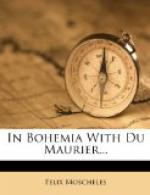As we now empty one or the other of the million bottles that are about, marked “De Soria, Bordeaux,” we often think with gratitude of the great wine-grower and still greater singer, so correctly described as “singing best for love or glory in the studios of his friends.”
To return to Arthur Lewis:—
He occupied an exceptional position, inasmuch as he had made his house a centre towards which intellectual London gravitated. When he had done this, that, and the other to make his bachelor days memorable to a host of friends, he wound up by marrying one of England’s fairest women, our great actress, Kate Terry. It was in those early days that Ellen, the debutante, was introduced to the dramatic world as “Kate Terry’s sister.” Since then Kate, having elected to rest on her laurels, is proud to be referred to by the younger generation as “Ellen Terry’s sister.”
In early life Lewis had various roads open to him. Born, as he was, with the capacity of a man of business, the means and opportunities of a man of leisure, and the talents of an artist, he managed to follow the three roads at the same time, and they all led to well-deserved success. He was to be found at his desk in Regent Street, at his easel in the studio, or on the threshold of that big billiard and reception room which he had built to entertain his friends. Himself an artist, and for many years a regular exhibitor at the Royal Academy, he was on terms of close friendship with the men who had made their mark in the art-world, and with many who were destined to become famous. He was a Maecenas of the right sort, knowing a good thing when he came across it, and frequently acquiring it before the sleepy world awoke to its merits.
I well recollect the enthusiasm with which he welcomed the first pictures Joseph Israels exhibited in England in 1862. Neither in the English nor in the Dutch department of the Exhibition could he ascertain whether these two pictures, “The Drowned Fisherman” and “Washing the Cradle,” were for sale. But luck would have it that he was introduced to Israels at the Academy soiree, and the artist, assuring him that the pictures were “certainly for sale,” Lewis secured the coveted works, and was thus the first to establish Israels’ fame in England.
The gatherings in Moray Lodge were unique in their way. It was characteristic of the master and the house that they made everybody feel at home, from the titled aristocrat in the dress-suit to the free-and-easy brother-brush or pen, and the sometimes out-at-elbow friend Bohemian.
There was the Duke of Sutherland, the Marquis of Lorne, Lord Dufferin, Mr. Frederic Leighton, Associate of the Royal Academy, Fred Walker, who sang tenor in the choir, of which more presently, and who on several occasions designed the cards of invitation for Lewis. There was Lord Houghton, Charles Dickens, Wilkie Collins, Rossetti, Landseer, Daubigny, Gustave Dore, Arthur Sullivan, Leech, Keene, Tenniel, &c., &c. It is as hard to pass those names over without comment as it must have been to run the gauntlet of Scylla and Charybdis, for every one of them brings back some recollection, and calls upon the pen to start a paragraph with an “I well remember.”




